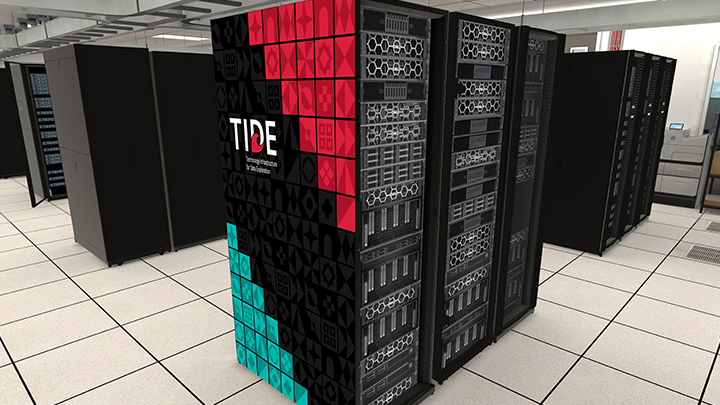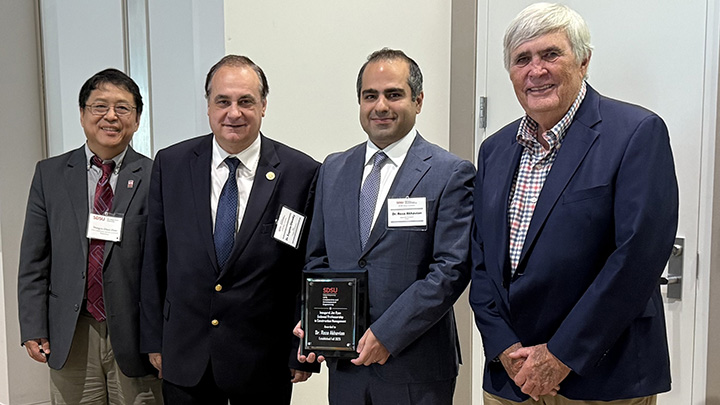SDSU, CSU gets major cyberinfrastructure upgrade for research
New grant for artificial intelligence and machine learning processing power will expedite high-performance computing research across campuses

San Diego State University, with partners from three California State University (CSU) campuses and the San Diego Supercomputer Center at University of California San Diego, is leading the way on a new project that will upgrade high-performance computing capabilities and increase access to advanced computing for faculty and student researchers across the CSU.
The Technology Infrastructure for Data Exploration (TIDE) project, backed by a $991,749 grant from the National Science Foundation’s Office of Advanced Cyberinfrastructure, will use high-performance graphical processing computing servers to expedite artificial intelligence and machine learning calculations, which previously required days to complete on less powerful machines.
In addition to purchasing new equipment, the grant aims to broaden access to high-performance computing (HPC) by providing high-quality training to staff, faculty, and student researchers.
Nearly 700 new computing cores, purchased from Dell Technologies, will be housed at SDSU's Campus Data Center but accessible to collaborators at an initial set of seven institutions — including researchers from the CSU campuses of Humboldt, San Bernardino and Stanislaus — who are part of the TIDE project team.
“The TIDE project funded by NSF is transformational for the CSU because it represents the first computational shared service for science in the history of our system,” said Jerry Sheehan, an adjunct faculty member at SDSU and the project’s principal investigator.
“Collaborating across our partner campuses, we have made a profound equity argument that spurred federal investment to enable research and discovery,” said Sheehan, the former chief information officer at SDSU and now the Salk Institute’s chief information officer.
Access to these advanced computers and their faster analysis will enable researchers to identify antibiotic-resistant tuberculosis strains, program robots to be more human in their interactions, and digitally reconstruct archaeological artifacts.
Installation and setup are expected to be complete by April 2024, with researchers gaining access in May 2024.
TIDE will provide funding for support staff at collaborator institutions, through graduate student assistants. Several of these support staff will be cyberinfrastructure professionals (CIPs), trained through a separate NSF-funded partnership between the San Diego Supercomputer Center (SDSC), SDSU, and CSU San Bernardino. CIPs at SDSU have already provided students in multiple classes with high-performance computing resources as part of an instructional cluster.
“The Cyberinfrastructure Professional (CIP) Fellows Program, supported by NSF funding (award #2230127), aims to train CI Professionals to facilitate science, engineering, and computing projects to utilize the CI resources offered by TIDE, and we look forward to accelerating the research goals of the CSU research community,” said Mary Thomas (‘85, ‘99), high-performance computing (HPC) lead for SDSC.
The third essential component of TIDE is that the initiative integrates the CSU into the “bring-your-own-hardware” model of the National Research Platform Nautilus Hyper-Cluster. This federally funded initiative is a massive network of distributed computers with built-in system administration, freeing up personnel resources to focus on research.
“The National Research Platform was built to support awards like TIDE. SDSC is thus excited to work with SDSU, CSU San Bernardino, Stanislaus State, and Cal Poly Humboldt on expanding scientific computing and AI across the CSU system,” said Frank Wuerthwein, director of SDSC.
Ultimately, these efforts aim to democratize access to computing skills and high-impact research experiences that would otherwise be unattainable, said Michael Farley, SDSU’s chief technology research officer.
Beyond facilitating faculty research, TIDE equips students with the technical know-how and meaningful contexts to develop their skills, preparing them for in-demand and high-paying careers in science, technology, engineering and mathematics.
“The addition of Dell PowerEdge R760XA and R760 servers to SDSU’s Campus Data Center will help introduce a wide array of students to the world of AI and machine learning-powered research in the fields of computational chemistry, digital archaeology and others,” said Dave Lincoln, vice president of Compute Systems, Dell Technologies. “The impact of this innovation at SDSU will help ensure greater access to powerful HPC infrastructure and further diversify the sciences.”


